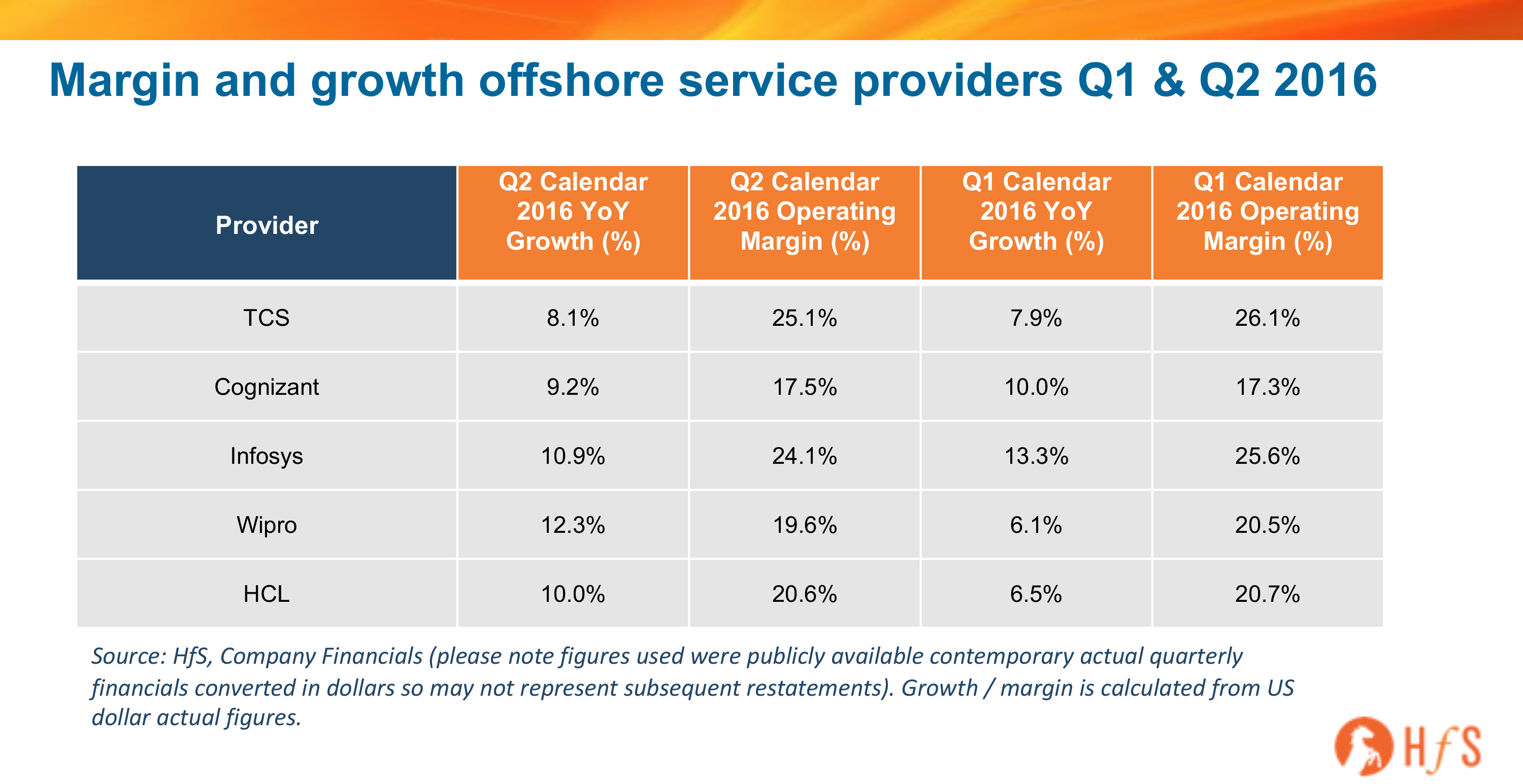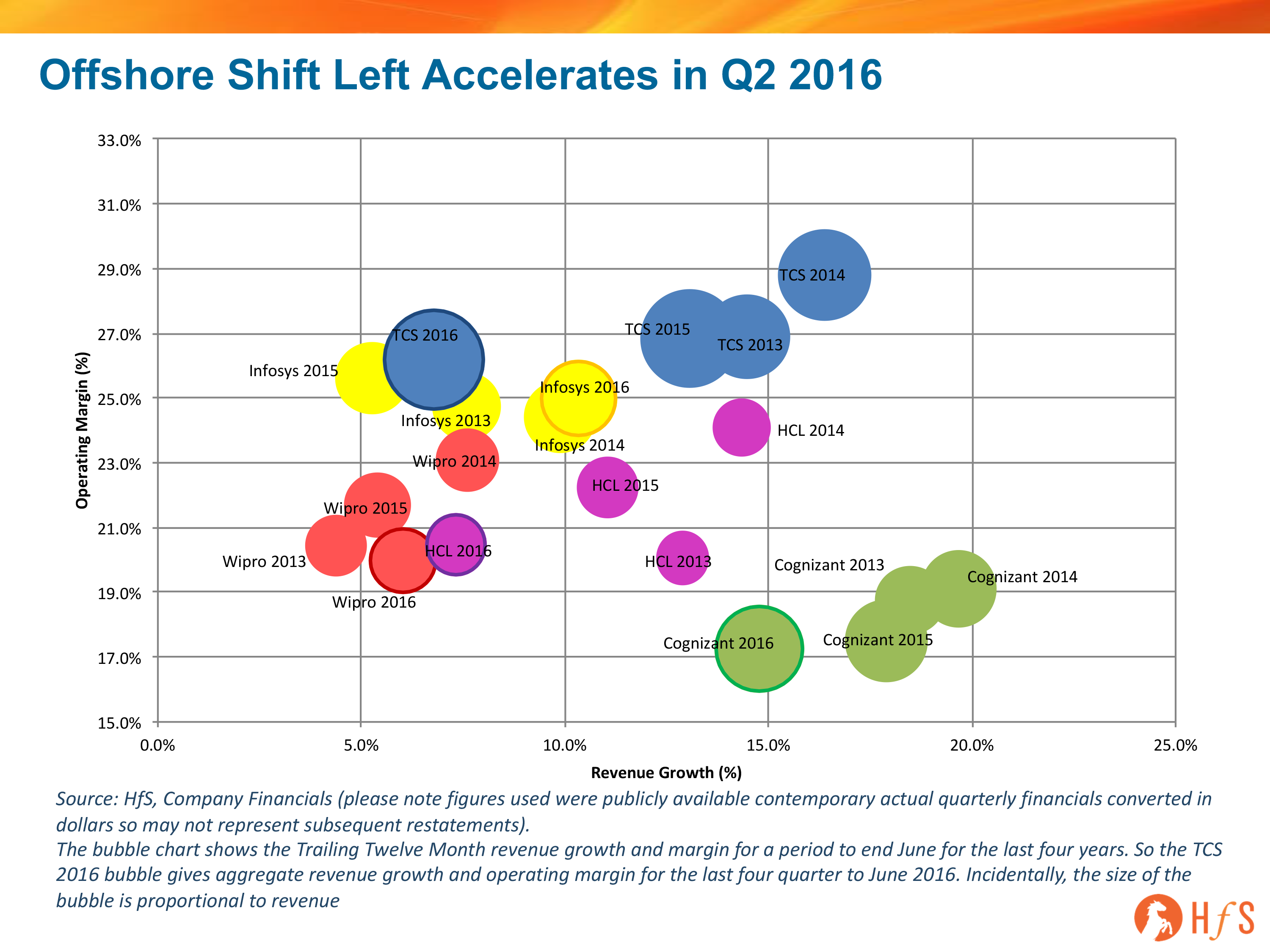Q2 2016 has been an exciting quarter of results so far, with a few surprises particularly amongst the large offshore providers. We commented on the pressure on Infosys caused by its results last month.
We see a real change in fortune amongst the big players, certainly over the last two quarters. With the players with strongest growth rates over the last three years, TCS and Cognizant dropping year on year growth to single digit.

If you look longer term, the shift left of the big offshore players is accelerating—with these latest results accelerating this trend.
TCS, HCL, and Cognizant will see revenue growth slow dramatically over the last three years. The bubble chart shows the Trailing Twelve Month revenue growth and margin for a period to end June for the last four years. So the TCS 2016 bubble gives aggregate revenue growth and operating margin for the last four quarter to June 2016. Incidentally, the size of the bubble is proportional to revenue.

All of the providers have managed to keep operating margins within a fairly narrow range—certainly better than most of the traditional onshore IT and BPO players.
The reasons for the shift are complicated and intertwined. It is tempting to see the most consistent providers, in this case Cognizant and TC,S as bellwethers of the market—so the slowing down of these firms growth is a strong indication of a slowdown in the market overall. Although this, particularly when you look at Q2 results so far, isn’t borne out by other provider’s results, particularly Accenture, which had a bit of a barnstormer certainly compared to its recent results.
Another possibility is that the scale of these firms is getting to point that maintaining double-digit growth rates is such a large amount of actual dollars that these providers sales engines cannot fuel level of client acquisition. There is probably some truth in this and getting the size and shape of your sales team right is a major challenge for service providers at the moment—particularly given the current uncertainty in the market. However, given that both Cognizant and TCS achieved higher levels of dollar growth throughout 2010 and 2011—while they were half the size—makes this theory less appealing, and certainly isn’t the whole truth. In Q4 2010 (calendar to end December 2010) Cognizant added $408 million in revenue, and TCS added an impressive $607 million year on year. This is compared with $285 million and $326 million, respectively, in the latest quarter Q2 2016.
What has changed most is the market itself. Partly with the size of the engagements, we have seen the outsourcing bills in IT infrastructure tumble by 40-50% and in some cases 60%, which means renewals come in at reduced rates and expectations around cost savings continue to ramp up, especially since automation starts to add another lever to the cost saving toolkit. This is particularly crucial as Tier 2 offshore firms focus efforts on combining savings from even cheaper locations and automation to lick the remaining cream off many deals.
Although outsourcing was the example used, this is also impacting professional services, mainly implementation services. The increasing emphasis on technology driven by digital and customer centric solutions has produced many opportunities, and while the number of deals may have increased, the contracts remain relatively small. Reengineering a bank’s core applications is, in scale terms, 20 or 30 times the design and implementation of a mobile app. Additionally, digital deals are often more involved and have more complex requirements that draw on a broader set of skills. This is undoubtedly slowing the sales cycle and means the upfront effort to engage with these small deals is higher. The promise is that demonstrating competence and the ability to deliver value within these often high-profile engagements will bring further work downstream. The market is still awash with proof of concept digital deals and the converting these into more meaty engagements is taking its time. So, rather than a lack of absolute capacity in the offshore provider’s sales teams, it is the makeup of these teams that is taking the time to adapt to these new types of deal.
The Bottom Line: The market sands have shifted, and the impact is now being felt by offshore firms
OK—so we may start sounding like a bit of a broken record. However, long-term success in the services market is dependent on inertia or the lack of it. Providers that are reacting quickly to the changing market conditions are growing, and they’re not necessarily the low-cost offshore-centric providers. We are sticking to this message: the x-factor for an enterprise service provider is agility—both regarding the provider’s ability to adapt to the market conditions and capacity to deliver adaptive intelligent solutions to clients.
These firms are having to adapt to these changing conditions on the fly. Unfortunately, there is no timeout to use while you have to adjust your processes, bring in new skills or reenergize your sales teams.
We are keeping an eye on all the players in the market and are looking for signs of this agility being reflected in financial results—halting what seems like the inevitable shift left.
Posted in : IT Outsourcing / IT Services






